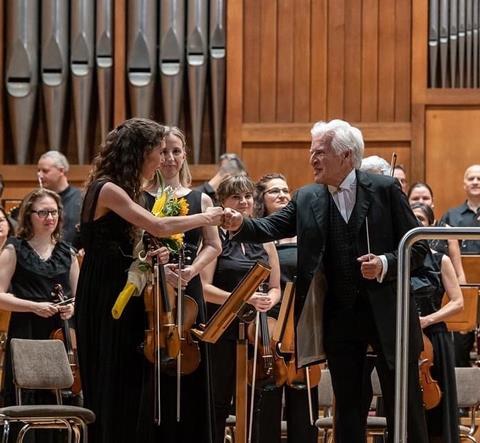Understanding how performance nerves manifest in yourself is the key to feeling comfortable on stage, writes the violinist

Discover more Technique articles like this in The Strad Playing Hub
As musicians, we are gifted the courageous task of creating art for others; a job that requires us to bare our skills, our convictions, and our creative souls on the stage. It’s incredibly rewarding work that demands dedication, passion, and resilience.
Musicians devote years of their life towards mastering their instruments, followed by months of practice and study towards each individual programme. Every performance is a culmination of those years and months of hard work, ultimately boiling all that time and effort down to an hour or so on stage, even minutes in the case of an audition. Performing can be a high-pressure situation, and the stress leading up to that culmination is very commonly accompanied with adrenaline and anxiety. Performance nerves are a reality for all musicians, and learning how to cope with the pressures of a performance is a significant part of our job.
Although dealing with nerves is a universal experience for all musicians, the result of those nerves are exhibited differently in every player. In order to better deal with those problems, it’s important to first identify how they are appearing in the individual, and how they affect the performance. For some, their performance nerves can appear as memory slips on stage, or a trembling bow, or even as technical mistakes like jumbled left-hand passages, or faulty intonation. Away from the instrument, our nerves can manifest physically, into tight muscles, redness, shortness of breath, sweating, loss of focus, even an upset stomach, while mentally manifesting as loss of confidence, anxiety or stage fright. If a musician can recognise how their nerves appear on stage, it becomes easier to manage the mental and physical symptoms of performance anxiety.
After a certain amount of experience, performers usually know which of these symptoms apply to them. If you’re still unsure of how your nerves appear on stage, or if it varies depending on repertoire or concert situation, frequently simulating that performance early on in preparation will quickly reveal the most persistent problems. Is your bow shaking at the beginning of sustained pianissimo phrases? Is one specific passage consistently going wrong in every practice performance, or is there one place that always challenges your memory? Do your muscles start to tighten or hands start to sweat while playing? Or, are your nerves more active in the time before the performance - inviting doubt and stage fright, anticipating failure regardless of your preparation?
Read: How can I help to conquer performance nerves by warming up my stiff, cold hands?
Read: The Inner Monsters responsible for performance nerves
Read more Technique articles like this in The Strad Playing Hub
When at their worst, I knew that my performance nerves usually resulted in a shaky bow or distorted articulation - mostly right arm problems - while my memory and left hand technique was reliable. Not only could you hear my nerves via shuddering bow-stroke, but you could see them; in the past it was fairly regular for me to develop hives before and during a concert, along with cramped muscles and loss of breath. Juggling these symptoms while trying to execute a successful live performance was incredibly difficult, but once I was able to recognise what were the pervasive issues in my nerves and how they appeared in my playing, versus what was stable, I was able to create the relevant solutions needed to tackle the problem.
Not only could you hear my nerves via shuddering bow-stroke, but you could see them; in the past it was fairly regular for me to develop hives before and during a concert, along with cramped muscles and loss of breath
Once a musician identifies how their specific performance nerves manifest, treating the symptoms becomes a matter of separating each issue and dealing with it individually, rather than as a general ’performance problem.’ Practice performances allow us to discover and alienate our obstacles - for example that one specific passage going wrong or that one place that leads to consistent memory slips - and prioritise those problems instead of worrying about your generalised playing or the entire piece. It is much easier to clean a few lines of tricky passages or enforce your memorisation in a particular spot than to worry about a piece in its entirety.
For myself, and those that also suffer from a trembling bow, that meant working on my nervous right arm; long, deep strokes focusing on pulling the sound from the string in the moments before stepping on stage. I found that a few minutes of open-string practice, grounding my right hand and right arm while prioritising a slow bow, was monumental in dispelling the shakes.

The physical symptoms of my nerves (the loss of breath and hives) certainly demanded some adaptations, like high-cut loose-fitting performance attire and some mandatory pre-concert breathing exercises, but with enough experience, they mostly disappeared on their own. Experience and preparation are crucial to quashing our performance nerves and feeling comfortable on stage. If musicians can practise being nervous, the stage becomes less frightening and more familiar. Simulating the stresses of a performance, like playing with an audience, in concert dress, playing the piece from start to finish, is essential to performance practice. It’s a method quite similar to exposure therapy; by regularly contending with our nerves, they eventually become less powerful.
After a musician understands the specific problems regarding their nerves, it is important to develop a performance plan for every programme that accommodates those problems. A musician has to know the personal structure of their piece- where it gets difficult, requiring extra focus or tension, and similarly, where the piece is less strenuous and perhaps more lyrical, allowing for some relief. A performance plan lets a musician know what to expect in their piece when going on stage, and allows the body and mind to prepare accordingly.
Perspective is most important to musicians when battling our nerves; acknowledging that there is no such thing as a ’perfect’ live performance, nor is a technically perfect performance our goal. A successful live performance is one that is musically interesting, emotional, informed and compelling, but by no means perfect. Once musicians can accept that our nerves, and the mistakes that come along with them, are not mutually exclusive to a successful performance, we can truly start to enjoy our time on stage.
Read: From the Archive: How to memorise solos
Read: How to use the 4 types of memory to improve your memorisation: Alexandra Gorski
Read: Performance anxiety: Fighting stage demons
Explore more Technique articles like this in The Strad Playing Hub











































No comments yet